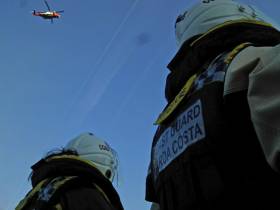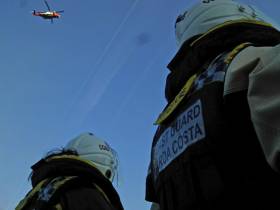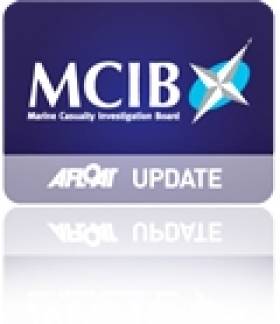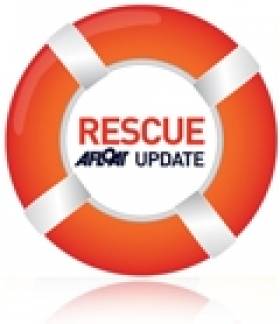Displaying items by tag: Rescue 116
#Rescue116 - One person has been taken from the scene in the search for an Irish Coast Guard helicopter and crew that went missing off Mayo in the early hours of this morning, according to the Galway Advertiser.
Update 2.55pm: The Irish Times confirms that the casualty recovered this morning, named as Captain Dara Fitzpatrick, was pronounced dead in hospital. Capt Fitzpatrick was one of the Irish Coast Guard's most senior helicopter pilots, and in 2013 flew Ireland's first missions with an all-female flight crew.
As previously reported on Afloat.ie, a major search operation was launched some six miles west of Blacksod at 1am this morning (Tuesday 14 March) after contact was lost with the Dublin-based Rescue 116 as it provided top cover during a rescue mission.
Coastguard officials conformed that four crew were on board the Sikorsky S92 long-range SAR aircraft at the time.
The individual recovered from the scene within the last 30 minutes is reportedly in critical condition.
New Coastguard Helicopter Hangar For Dublin Airport
#Coastguard - This month sees the start of construction of a new hangar at Dublin Airport for the Irish Coast Guard helicopter fleet, as Coast Monkey reports.
The new operations centre at the current base for Rescue 116 comes half-way into CHC Ireland’s 10-year contract to provide coastguard search and rescue services.
Works to be completed by the middle of next year will see the demolition of the existing 600 sqm hangar with a 2,000 sqm facility from where Ireland’s four SAR bases — at Dublin, Sligo, Shannon and Waterford — will be co-ordinated.
Coast Monkey has more on the story HERE.
Body Found In Search For Missing Dalkey Island Swimmer
#MissingSwimmer - RTÉ News is reporting that a swimmer taken from the water after going missing off Dalkey Island in Dublin Bay this morning (Sunday 7 April) has died.
Earlier this evening The Irish Times reported that the 35-year-old man was in a critical condition in Tallaght Hospital after being recovered from the water off Sorrento Terrace.
Lifeboat volunteers with Dun Laoghaire RNLI and the Irish Coast Guard's Dublin-based helicopter Rescue 116 were involved in the search which began around 11am today after the swimmer failed to return to shore.
Epilepsy, Lack of Lifejacket Big Factors in Death of Dublin Boatman - MCIB
#MCIB - The death by drowning of a South Dublin boatman may have been avoided had he been wearing a lifejacket or buoyancy aid, according to investigators.
The report by the Marine Casualty Investigation Board (MCIB) into the death of Aidan Fennell off Dalkey Island on 12 October 2010 found that an epileptic episode could have caused him to fall overboard from his rowboat and become disorientated once in the water.
Fennell, 43, was considered a competent boatman and a strong swimmer used to cold water, though was prone to seizures where he could not control his muscles and lost sense with reality, on occasion becoming unconscious.
On the afternoon of 12 October last year Fennell had launched his boat from Coliemore Harbour in fair conditions, intending to ferry a German family to Dalkey Island. When they pulled out of the trip, Fennell decided to row to the island on his own, with no flotation devices on board.
He was last seen by friend Kevin O'Farrell at 2.50pm. Around half an hour later, O'Farrell became concerned as to Fennell's whereabouts when he had been out of sight for some time.
After notifying the Irish Coast Guard, the Dun Laoghaire lifeboat and coastguard helicopter Rescue 116 were dispatched to search the area. Fennell's boat was located before 4pm washed on the rocks at the southeast end of Dalkey Island, and his body was found in the water close by some 10 minutes later.
No injuries were found on Fennell's body, suggesting that he went into the water before his boat washed up on the rocks.
The report concluded that if he had fallen overboard in normal conditions "it is considered likely that he could have swum to his boat, or clung on to the oars.
"However, if he had suffered an epileptic episode... he would have had great difficulty in staying afloat, in particular without having the buoyancy assistance of a life jacket."
The full report is available to download as a PDF from the MCIB website HERE.
Woman Rescued from Water at Howth Head
Irish Coast Guard helicopter Rescue 116 was on hand Wednesday to save a woman seen in the water close to cliffs near the Baily Lighthouse on Howth Head.
SAR Ireland reports that the helicopter was on a training exercise just up the coast in Malahide when passers-by raised the alarm with the Marine Rescue Coordination Centre (MRCC).
Rescue 116 sped to the scene and after a short low-level search the woman was spotted and taken to a waiting ambulance at the coastguard base for treatment.
The Irish Times says Howth gardaí are investigating the incident.
Lifejacket Saves Boy in Lough Ramor
A lifejacket was key to saving a youg boy's life when he was thrown from his boat in Lough Ramor on Sunday afternoon.
The 14-year-old was the sole occupant of a RIB on the Co Cavan lough, and had failed to secure the emergency engine stop cord to his body before he went overboard.
But his lifejacket kept him afloat while a passer-by raised the alarm.
SAR Ireland reports that Coast Guard helicopter Rescue 116 was dispatched from Dublin in response, but was stood down when the boat owner, who has been contacted by gardaí, was able to rescue the youngster.


































































